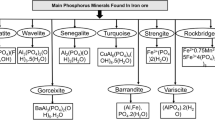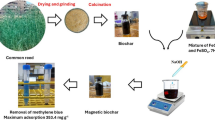Abstract
Reverse flotation studies on magnetite samples have revealed that the use of starch as a depressant of Fe-oxides has a hydrophilic effect on the surface of Fe-bearing silicates and significantly decreases Fe in the silica-rich stream when used in combination with an amine (Lilaflot D817M). In this study, the effect of reverse flotation on the optimization of products obtained from magnetic separation was investigated. Two different magnetic samples, zones 1 and 2, were milled to <75 μm and then subjected to low intensity magnetic separation (LIMS). The LIMS test conducted on the <75 μm shown an upgrade of 46.40wt% Fe, 28.40wt% SiO2 and 2.61wt% MnO for zone 1 and 47.60wt% Fe, 29.17wt% SiO2 and 0.50wt% MnO for zone 2. Further milling of the ore to <25 μm resulted in a higher magnetic-rich product after magnetic separation. Reverse flotation tests were conducted on the agitated magnetic concentrate feed, and the result shows a significant upgrade of Fe compared to that obtained from the non-agitated feed. Iron concentrations greater than 69%, and SiO2 concentrations less than 2% with overall magnetite recoveries greater than 67% and 71% were obtained for zones 1 and 2, respectively.
Similar content being viewed by others
References
G. Özbayoglu, C. Hosten, U. Atalay, C. Hiçyilmaz, and A.I. Arol, Mineral processing on the verge of the 21st century, [in] Proceedings of the Eighth International Mineral Processing Symposium, Antalya, Turkey, 2000, p.271.
S. Mathur, P. Singh, and B.M. Moudgil, Advances in selective flocculation technology for solid-solid separations, Int. J. Miner. Process., 58(2000), p.201.
T.V.V. Kumar, D.S. Rao, S.S. Rao, S. Prabhakar, and G.B. Raju, Reverse flotation studies on an Indian low grade iron ore slimes, Int. J. Eng. Sci. Technol., 2(2010), p.637.
S. Ersayin and I. Iwasaki, Magnetic field application in cationic silica flotation of magnetic taconite concentrates, Miner. Metall. Process., 19(2002), p.148.
M. Birinci, J.D. Miller, M. Sarıkaya, and X. Wang, The effect of an external magnetic field on cationic flotation of quartz from magnetite, Miner. Eng., 23(2010), p.813.
B. Das, B.K. Mishra, S. Prakash, S.K. Das, P.S.R. Reddy, and S.I. Angadi, Magnetic and flotation studies of banded hematite quartzite (BHQ) ore for the production of pellet grade concentrate, Int. J. Miner. Metall. Mater., 17(2010), p.675.
S. Pavlovic and P.R.G. Brandão, Adsorption of starch, amylose, amylopectin and glucose monomer and their effect on the flotation of hematite and quartz, Miner. Eng., 16(2003), p.1117.
L.O. Filippov, I.V. Filippova, and V.V. Severov, The use of collectors mixture in the reverse cationic flotation of magnetite ore: the role of Fe-bearing silicates, Miner. Eng., 23(2010), p.91.
Author information
Authors and Affiliations
Corresponding author
Rights and permissions
About this article
Cite this article
Bada, S.O., Afolabi, A.S. & Makhula, M.J. Effect of reverse flotation on magnetic separation concentrates. Int J Miner Metall Mater 19, 669–674 (2012). https://doi.org/10.1007/s12613-012-0611-5
Received:
Revised:
Accepted:
Published:
Issue Date:
DOI: https://doi.org/10.1007/s12613-012-0611-5




